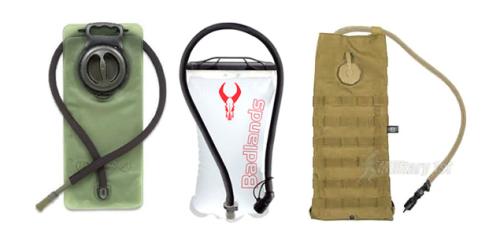Water Bladders
December 22 2015
Pros
- Allow greater quantities of water to be carried
- Facilitates drinking with minimal effort
- Can contain filters
- Easily incorporated into equipment
Cons
- Not always as durable as needed
- Can cause nausea/ illness if not routinely maintained/ cleaned
- Can create dangerous/ sole dependency on one source
Proper Hydration is one of the most essential items on the hierarchy of basic survival, second only to shelter/ heat in order of importance. Even though the average person can survive approximately 3 weeks without food, without a quality source of water, they would probably die within 3 days or so. Remaining hydrated is also among the healthiest things we can do for ourselves while in the outdoors. The human body's basic function demands the proper levels of hydration and electrolyte balance for optimum performance. Water bladders and the distinct packs that utilize or incorporate them into the design, transpires that water is more accessible and easier to carry than ever before. This allows users to carry water for easy drinking and do so without removing gear and equipment. Hikers used to have to stop for a water break, pulling out bottles and then constantly repacking everything before getting back on the trail, while military personnel, would have to provide security for each other to take a drink from a canteen.
Another positive element to consider in usage of water bladders, is allowing the carry and storage of larger quantities of water than previously available with the use of canteens or plastic-bottles. The included uniquely designed hose/ nozzle combination facilitates drinking directly from the reservoir without removal of the bladder from the pack, ensuring proper hydration even while on the move. Some water bladders even mate with filters, to enable drinking from otherwise unsafe/ unknown sources. Proper hydration is now as simple as grabbing a hose and taking a drink, without time wasting stop-and-go. Additionally, bladders can be frozen and allowed to thaw naturally while outdoors, allowing the user a constant and cool supply of water to enjoy.
A potential drawback of water bladders, is the possibility for the bladder to rupture/ hose to come loose when excessive force is applied to the pack (exterior of bladder). The uncomfortable sensation that accompanies 2 -3 liters of water flowing down the user's back and legs, pales in comparison to the far more serious problem of losing the primary source of water. This can be averted by adequate planning/ packing of equipment. In addition, if these bladders are not routinely cleaned and maintained, traditionally have mold/ fungus begin to accumulate within them as well as the hose. When this occurs, the user could ingest harmful substances that can cause serious illness or worse, dehydration. This can be avoided by properly cleaning and maintaining the bladder, hoses, filters, and connectors.
Another key issue to consider is not in direct relation to the actual water bladders, but with the users that don't plan for additional sources of water when they should. While it is possible to carry a good amount of water in bladder(s), when attempting multi-day events, users should make additional preparations or have extra contingencies in place for carrying additional water as a safety measure.
In summary, bladders can provide a safe, convenient, easy way to carry large amounts of water, while being moderately low maintenance and make a worthwhile addition to a pack. With the minimal required care and cleaning, they will provide years of reliable use.
Add New
Comments
no comments found
